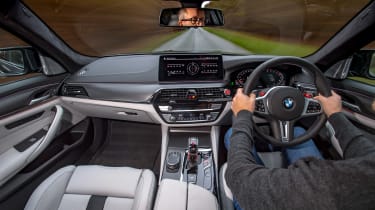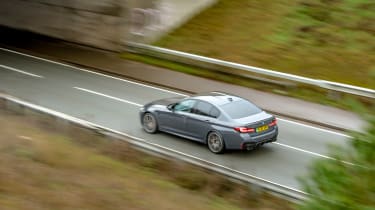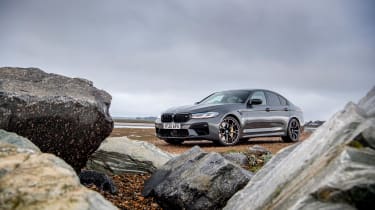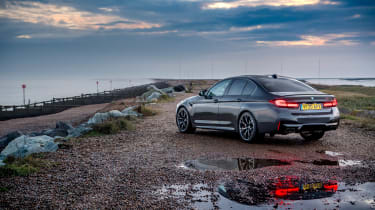Power of M
The 2021 M5 Competition is the latest in a long line of great M-cars. We go for a celebratory drive and recall some of its forebears
Did the 33-year old Jochen Neerpasch know what he was starting when he agreed to lead BMW’s new dedicated motorsport division in 1972? A sidearm of a car company that was already well on its way to positioning itself as the preferred alternative to the rather steadier approach favoured by Audi and Mercedes-Benz, Neerpasch was to grow BMW’s motorsport activities to suit the needs of customers who wanted to compete with a BMW on track as well as enjoying them on the road.
It was an exercise that started with the 3.0 CSL, a lightweight, two-door, rear-wheel-drive coupe powered by a 3-litre six-cylinder engine built to meet the homologation requirements of the European Touring Car Championship. Today it embraces a mix of eight coupes and saloons (including the forthcoming M3 and M4 models) and four SUVs, and this takes into account only the UK line-up, which comprises the Competition models; include the regular non-Competition models sold around the globe and the two dozen M-cars on today’s product plan is only 11 shy of the total number of employees Neerpasch had working under him during M’s early days.
It is even less likely that 40 years ago Neerpasch and his M team could have envisaged that their first properly sporting saloon, the understated E12 M535i, would evolve into a 616bhp, four-wheel-drive supersaloon that’s just as capable of reaching not far off the double-ton as it is carrying five passengers and their overnight bags in a level of opulence that wouldn’t be out of place in a 7-series. Today’s M5 Competition remains the definitive supersaloon, even in a sector that has seen the number of incumbents increase over the last four decades by at least a factor of ten.
Challengers and pretenders to the throne have been more powerful, faster, more accelerative, more luxurious, more exclusive. A few have carried more prestigious names or arrived with closer family ties to sports and supercars. Yet few have come close to matching any generation of M5 in all the key areas that define the breed, and this new M5 Comp is no different. If there is a chink in the M5’s armour, it could be that it is such an accomplished all-round package – and one that has stuck steadfastly to its original remit – that it can often be overlooked because its rivals shout louder while the M5 just gets on with it.
There is a great deal for the Bavarian beast to be confident about today. That confidence has been ever-present since the days of the E28, through E34 and E39, and not forgetting the divine madness of the E60’s screaming V10. Today’s twin-turbocharged V8 formula might have calmed the revs but the M5 remains a car you will always want in your corner. One that exudes a calm superiority as you approach. It may lack the visual drama of some of its rivals, but then the M5 has never been the extrovert type, preferring the subtle approach of squeezing the hardware required to let it sniff the exhaust of a 911 into the outline of a four-door saloon that is also available as a tax-efficient plug-in hybrid.
On a filthy winter’s night, the facelifted M5 Competition (new front bumper, splitter, bonnet and adaptive LED headlamps at the front; new bootlid and lip spoiler, exhaust system and LED lights at the rear) continues to demonstrates M’s expertise in creating a saloon car with a level of performance to embarrass a supercar. It starts with its S63 twin-turbocharged 4.4-litre V8, which has a depth and an authenticity to its tone right from start-up: an old-school gentle rumble as those eight cylinders calmly tick over, no shouty start-up procedure and no unnecessary bark from the exhaust to draw attention.
Yet once on the move this V8 certainly knows how to grab your attention. There’s a straight-six smoothness to how it builds revs, a crispness to its responses that’s a throwback to the days of the M88 motor fitted behind the shark-nose of the E28, and the first incarnation of the S38 six found behind the softer face of the E34. Even at half-throttle and using barely half the revs available to you, today’s engine responds with an eagerness that’s closer to its junior sibling the M2 coupe than a large-capacity V8 in a saloon car.
It’s when it hits its peak that today’s M5 demonstrates its power advantage with an expletive-inducing explosion of performance as the pair of turbos spool up. And it keeps on revving, dispelling the myths associated with large-capacity forced-induction engines. Its tone might not reach the demonic high notes of the E60’s Formula 1-derived V10, but this ‘hot-vee’ motor is every bit as keen to rev as the 5-litre, naturally aspirated V8 in the E39-gen car.
There’s ample power and torque right across the engine’s range, the maximum torque of 553lb ft being available from as low as 1800rpm, resulting in a mind-scrambling level of performance when the mood takes you. Let loose and allowed the freedom to breathe as much air as it needs to burn the 98 RON fuel being injected into its heart, this V8 punches harder and stronger than many give it credit for. Given its head on a circuit, you find yourself arriving at braking points far sooner and carrying much more speed than you perhaps anticipated was possible for a car of this size. And the M5 certainly has grown over the years; four decades of development – largely in safety and technology – have seen the model gain 35cm in wheelbase length, 20cm in width and 572kg in kerb weight.
Size and weight naturally have an effect on dynamics; manufacturers are open about such matters, and M division is no different. The on-its-toes feel of the early six-cylinder cars evolved with the first V8 M5, its dynamic envelope broadened to embrace the performance leap that had taken place. And the pattern has been repeated ever since, the engineers honing each chassis to allow maximum exposure to the heightened performance offered with each new generation. Not all of the M5’s rivals over the years have been able to pull this off. Where some have delivered precise dynamics with rather blunt instruments of motors, or effervescent motors tied to damp-squib chassis, the M5 can be relied upon to blend the best of both.
Inevitably we’ve seen the increasing application of driver aids and driving modes, and despite its Competition moniker the latest M5 is no different. In fact, the F90 is the most technologically advanced M5 of all time and sets the template for today’s modern family of M-cars. What was once considered Tomorrow’s World tech is now a default action, each journey starting with a press of a button to adjust steering, damper and throttle maps. ‘Sport, comfort, sport’ is the evo default, pre-set to one of the red, fingertip-sized ‘M’ buttons on the steering wheel.
Additional weight to the steering is just that, something extra to lean against rather than additional feel coming back from the front pair of Pirelli P Zeros wrapped around the 20in wheels. When it comes to ride quality, the 2021 M5 Competition removes a layer of pliancy from the pre-facelift standard car, resulting in some low-speed interference through the cabin that drifts away as you pick up the pace. This is the engineers sacrificing some level of comfort in order to improve body control and tighten the chassis, thus providing a clearer step up from the standard M5 models. While the Comfort setting for the throttle map holds back none of the performance, you want Sport as your default; after all, why pay the extra to have that potent V8 at your disposal if you experience it in its most muted setting?
On smaller roads the M5 is no M2 CS, but then you wouldn’t expect the same level of focus. In the M5 you take a more measured approach, with less throttle and calmer inputs through the steering, chassis and brakes to maintain a smoothness to your progress. Where Audi’s RS6 needs poking to get a reaction and AMG’s E63 always feels like it’s straining at the leash, the M5 finds its rhythm early and happily builds upon it with you. It’s why, regardless of its switchable four-wheel-drive system and eight-speed automatic gearbox, there are times when the F90 flows with the elegance and precision of an E34.
It’s when you dive into the configurable menus that an even richer stream of M5 DNA percolates through today’s example. On first acquaintances the switchable four-wheel drive xDrive system seems overly complex for a four-door saloon car designed to cover distances at a serious pace in sublime comfort. But it takes little time for you to start experimenting with it, even if it’s primarily to confirm your cynicism for such systems.
And then it doesn’t take long for the cynicism to subside. On the road your instincts (and sanity) persuade you that power and torque should still be sent to both axles, but with MDM mode engaged, which slackens off the traction and stability systems just enough to add a more textured layer of involvement. Your senses are heightened and the car feels less restricted, still tied down but with the safety straps loosened. It means that 616bhp and 553lb ft of torque isn’t the intimidating combination your grey matter tells you it should be, rather it becomes a source of energy to enjoy.
But there’s another dimension to the M5 experience. There’s always been a sharpness to the F90’s steering and dynamics and that’s still clearly evident with this latest Competition model, so when you decide it’s time to step up to the challenge of a 616bhp rear-drive supersaloon, switching to rear-wheel drive secures a sweeter connection between you and the car.
In slower corners it’s now up to you to manage the power and torque delivery as you take advantage of a front axle that now only has to deal with the task of steering – and a pair of rear tyres that could disappear in a plume of rubber smoke if your right foot goes all out. Yet, regardless of the drivetrain setting, if you’re measured and precise this near-five-metre-long saloon car feels half its size, performing with a confidence that’s totally unexpected, especially to those in the rear seats streaming Netflix through the in-built entertainment system!
Forty years ago the E12 M535i created a blueprint that resulted in the first M5, powered by the motorsport-derived 3.5-litre six-cylinder engine that had been the heart and soul of BMW’s only bona fide supercar, the M1. Since then the M5 has evolved, grown in every measurable way, and while rivals have come, gone and stuck around, the original Bavarian bruiser remains a cult classic. So while its future will undoubtedly involve an element of electrification, if the last four decades have shown us anything it’s that the M5 is capable of remaining true to its roots.










